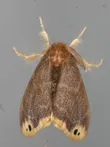
Harmful Effects of Orvasca subnotata
A species of Orvasca
Exposure to orvasca subnotata can cause allergic reactions in humans, typically through contact or inhalation of larval hair. Symptoms range from mild itching to respiratory issues, with severity varying per individual. These conditions are not life-threatening but may necessitate medical attention. Precautions are advised when near orvasca subnotata.
Does the Orvasca subnotata cause allergies?
Harmful Facts About Orvasca subnotata
What Type of Pest Is Orvasca subnotata?









AI entomologist in your pocket
Scan QR code to download

